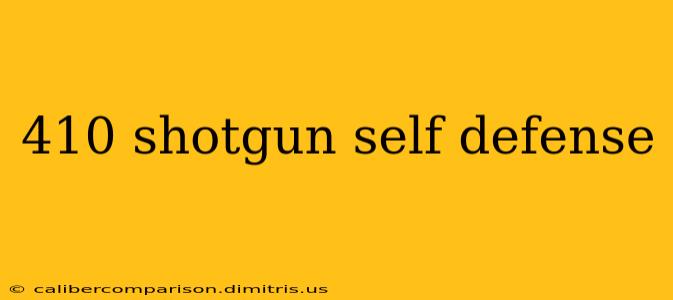The 410 bore shotgun is often touted as a viable self-defense option, particularly for its compact size and ease of handling. However, its suitability for self-defense is a complex issue demanding careful consideration. This article delves into the pros and cons of using a 410 shotgun for self-defense, providing a realistic assessment based on ballistic performance, legal considerations, and practical applications.
Ballistic Performance: The 410's Limitations
While the 410 gauge is undeniably compact and easy to maneuver, its effectiveness as a self-defense weapon hinges on its ballistic performance. Compared to larger gauges like 12 or 20, the 410 boasts significantly less stopping power. This stems from several factors:
-
Reduced Shot Size & Payload: The smaller bore means fewer pellets per shell and generally smaller pellet sizes. This translates to a lower density of shot impacting the target, potentially reducing its incapacitation potential.
-
Shorter Effective Range: The 410's limited shot spread and lower muzzle velocity result in a shorter effective range. Accurate shot placement becomes exponentially more challenging at greater distances.
-
Recoil Management: While the recoil is generally manageable, particularly in shorter-barreled models, consistent accuracy under stress can be difficult to achieve for those unaccustomed to the weapon.
Legal Considerations: A Complex Landscape
The legality of using a 410 shotgun for self-defense varies significantly by jurisdiction. While some areas may permit its use with minimal restrictions, others impose limitations or outright bans depending on factors such as:
-
State & Local Laws: Specific regulations regarding firearm ownership, self-defense laws, and permissible weapons vary widely. Research your local and state laws thoroughly before considering any firearm for self-defense.
-
Concealed Carry Permits: Carrying a 410 shotgun concealed might be subject to different restrictions than carrying a handgun. Check your local regulations on concealed carry permits and permissible weapons.
-
Use of Force Laws: Understanding your state’s "stand your ground" laws and the legal requirements for justifiable self-defense is crucial. Improper use of a firearm, even in self-defense, can lead to severe legal repercussions.
Practical Considerations: Beyond Ballistics
Beyond the ballistic performance and legal aspects, consider the following practical points:
-
Training and Proficiency: Regardless of the chosen firearm, adequate training is paramount. Mastering safe handling, proper shooting techniques, and effective self-defense strategies are non-negotiable. A 410 shotgun requires specific training to mitigate its limitations.
-
Accessibility and Deployment: The ease of handling is a plus, but quick and efficient deployment in a self-defense situation is also vital. Consider how easily you can access the weapon and bring it to bear effectively in a stressful situation.
-
Alternatives: Explore other self-defense options like pepper spray, personal alarms, or less-lethal weapons. These options may be more readily available, require less training, and pose less risk of legal repercussions.
Conclusion: A Carefully Considered Choice
The 410 shotgun, while compact and manageable, presents significant limitations as a primary self-defense weapon. Its reduced stopping power and shorter effective range necessitate highly accurate shot placement under stress, demanding extensive training and proficiency. Thorough research into local laws, comprehensive training, and careful consideration of alternative self-defense methods are crucial before selecting a 410 shotgun for self-protection. This article serves as a starting point for your research; consult with law enforcement and firearm training professionals for tailored guidance specific to your circumstances.

